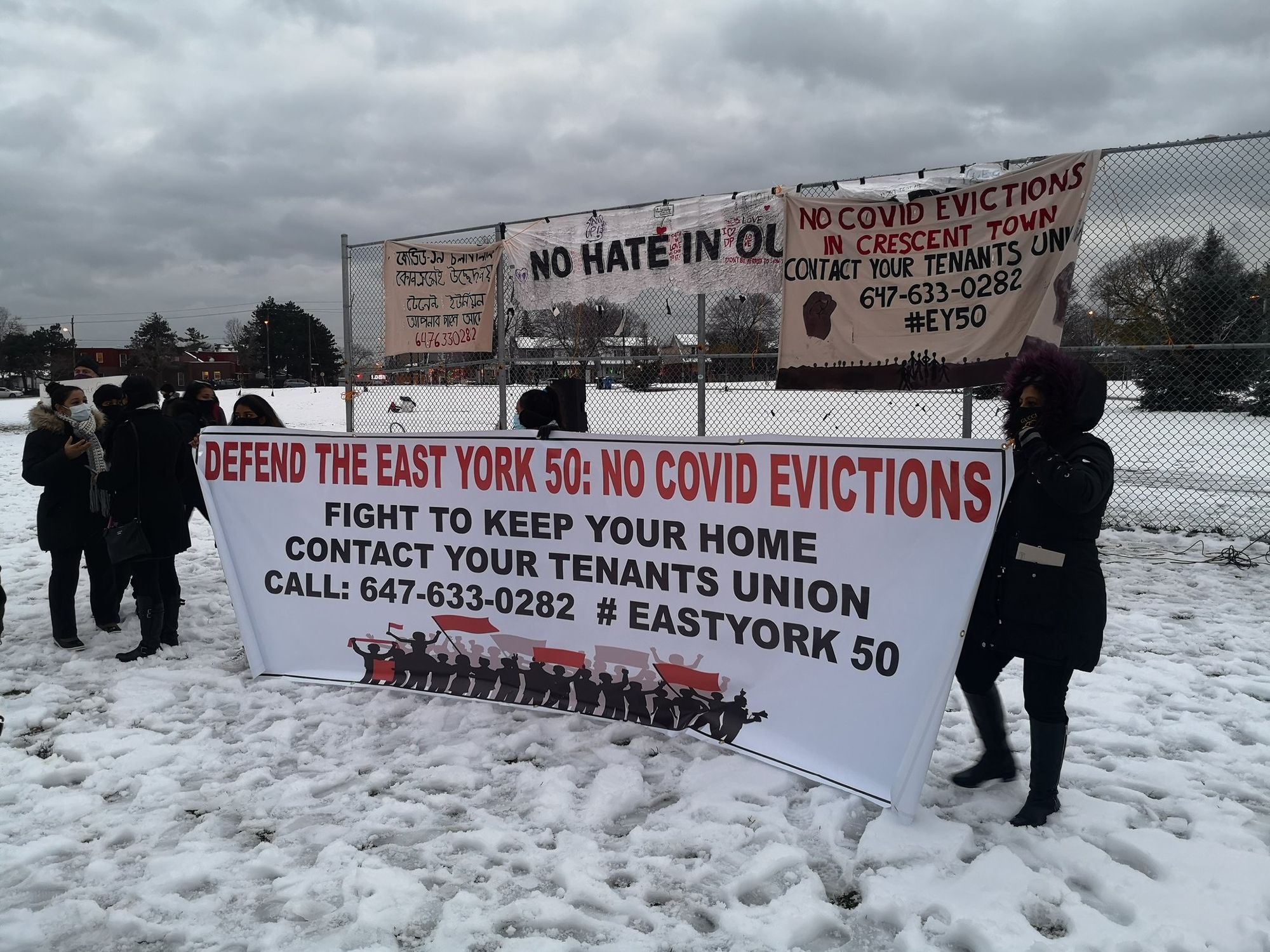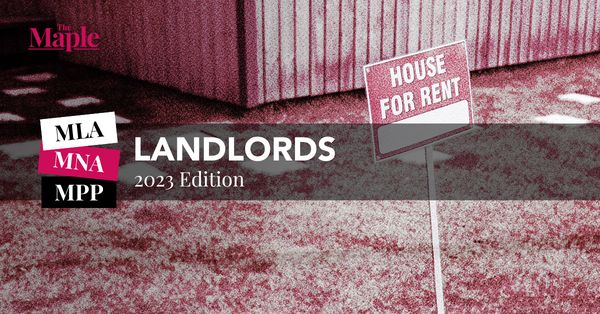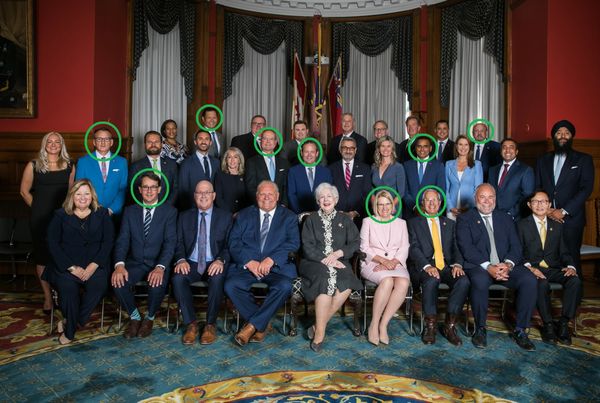The Canada Emergency Response Benefit (CERB) ended in October. In Toronto, where rent prices are unbearably high for working class tenants, the CERB wasn’t enough for those who were eligible to receive the benefit. As a result, tens of thousands of renters who have lost their jobs in this pandemic, and fell behind on their rent payments as a result, have been left without adequate support from the government or their landlords.
Now, with Ontario’s residential eviction moratorium having ended earlier this year, the mass eviction crisis is here. Last month in Toronto alone, the Landlord and Tenant Board (LTB) scheduled nearly 2,500 online hearings based on landlords’ applications to evict their tenants. Hundreds of people have already been removed from their homes by sheriffs and police.
The Eviction Blitz
Despite Toronto entering lockdown again in response to rising COVID-19 cases, the LTB has pushed ahead with its online eviction ‘blitz.’
Eviction hearings are conducted in two-hour “express” blocks in Microsoft Teams video conference rooms. Nine or more tenants’ cases are scheduled together in each block. In the virtual hearing rooms, politically-appointed adjudicators summarily order tenants to either pay large sums of rent arrears on impossibly short repayment schedules or be evicted by the sheriff.
In October, the LTB began to prioritize scheduling eviction hearings for tenants who missed rent payments during the shutdown. In cases where the tenant is unable to log or call in to the online platform, the hearing goes ahead in their absence, and their eviction is confirmed. Yet in cases where the landlord didn’t show, tenants have reported that adjudicators refused to consider the case abandoned by the landlord.
Tenants have been ordered to pay all rent arrears owing in full, plus the landlord’s eviction application filing fee (up to more than $200), within 11 days, or be evicted. The fact that there have been cases of the LTB failing to issue notice of the online hearing to the tenant in advance has led to legal aid lawyers speaking out in the media.
Tenants who have attended their eviction hearings report that the formality concludes in as little as 60 seconds. In one case reported by the Keep Your Rent advocacy group in its live tweets of LTB hearings, an adjudicator ordered the eviction of a tenant who didn’t appear to understand the terms because of a bad connection.
In the hearings, many tenants have been pressured into agreeing to terms of rent repayment that will be impossible for them to keep up with. For example, an agreement might have the tenant pay $500 each month toward rent arrears, totaling thousands of dollars on top of the tenant’s full monthly rent.
Adjudicators regularly remind tenants that if they’re ever “a day late or a dollar short” on even one scheduled monthly payment, their landlords can get an automatic eviction order without a hearing, enforceable by the sheriff. Based on my experience working with tenants who were pressured into such onerous repayment agreements, I know that many will be evicted within six months of their hearing, despite them continuing to hand over a massive portion of their incomes and foregoing basic necessities in order to pay their landlords back in full.
Many of the adjudicators who preside at the LTB hearings were appointed by Doug Ford’s government as recently as August in preparation for mass evictions. Tenant groups have sounded the alarm regarding these appointees having ties to real estate interests and the law firms that represent them.
One LTB adjudicator, who is associated with the landlord-side law firm Cohen Highley LLP, has been reported for having decided eviction cases in which the landlord was represented by an employee of the same firm. Cohen Highley describes itself as “Ontario’s premiere [sic] legal resource for residential landlords and property managers,” and works with the Federation Of Rental Housing Providers Of Ontario.
District Organizing
The eviction blitz hasn’t gone uncontested by organized tenants. For the past nine months, working class renters across Toronto have been at the forefront of organizing against evictions.
In August, on the first scheduled day of eviction enforcement, Toronto tenants blockaded the court enforcement office’s parking garage, preventing sheriffs from carrying out the day’s scheduled evictions. Later that month, tenants in Parkdale, a Toronto neighbourhood, were issued eviction notices in retaliation for bringing demands to improve their building’s condition to their landlord’s home. A coordinated response by the tenants and their neighbours in Parkdale succeeded in pressuring the landlord to withdraw the eviction notices.
In September, after keeping watch in turns for weeks, members of the Goodwood Tenants Union physically prevented sheriffs and Toronto police from removing their neighbour — an elderly, Indigenous tenant — from her home. Weeks later, Toronto police orchestrated a raid on the building on behalf of landlord Ranee Management. More than a dozen police officers covered the building’s elevators and stairwells in order to prevent members of the tenant union from mobilizing in their neighbour’s defence.
In October, the tenant union in the Crescent Town apartment complex in East York filled the hallway of the 21st floor of one of the district’s high rise buildings, and faced off against and turned away Toronto police tasked with removing a tenant from her home on behalf of landlord Pinedale Properties. At 2 a.m., after tenants had disbursed, police returned and illegally removed the tenant from her home. A successful legal challenge confirmed that the tenant had been illegally evicted, and her home has since been rightfully returned to her.
Earlier this month, tenants in Toronto’s Weston-area facing renoviction banded together and joined with local groups to demand that investors who recently bought their building drop the evictions. After confronting one investor at his home and holding a mass tenant meeting outside their building, the landlord caved and withdrew the eviction notices.
At the same time, tenants facing eviction at a four-building complex in Toronto’s west-end brought their demand for no COVID evictions to the mansion and offices of their landlord Tom Falus, a well-known Toronto real estate developer. On Sunday, a local tenant union in Weston rallied behind a member at risk of imminent eviction by rental real estate giant Starlight Investments. The landlord has since backed off and has agreed to negotiate with the union to keep the tenant in his home.
Last week, members of the East York 50, a group of tenants from the Goodwood Park, Crescent Town and Teesdale tenant unions, attended their neighbours’ eviction hearings en masse with their lawyers. They put forward a principled legal defense and intervened to ensure most of theirs and their neighbours’ cases were put over to a later date. The East York 50’s week culminated in a militant Friday evening demonstration that saw tenants march from their own district to Victoria Park and the Danforth, where they occupied the intersection to demand an LTB shutdown.
Capital depends on the core, productive and reproductive labour of the working class people hit hardest by the pandemic at the same time as it worsens their conditions. The mass eviction crisis is no accident. Politicians at all levels of government seek to impose discipline on the lower strata of the working class through financial insecurity and debt with no regard to the consequences. Eviction, homelessness, illness and death are considered to be acceptable outcomes of the state’s “recovery” policy.
Since the beginning of the pandemic, the experience of working class renters has been that the only relief from eviction available to them is that which is won through their organized struggle against landlords and the state.







Member discussion